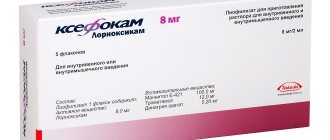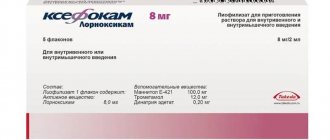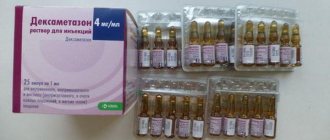Release form and composition
Dosage form - tablets: almost white or white, round, flat-cylindrical in shape, with a chamfer and a dividing line (in a strip pack: 10 pcs., 3 packs in a cardboard pack; 14 pcs., in a cardboard pack 1 or 2 packs) .
The active ingredient of Ramipril is ramipril, in 1 tablet – 2.5 mg, 5 mg or 10 mg.
Auxiliary components: lactose, microcrystalline cellulose, aerosil (colloidal silicon dioxide), magnesium stearate, Primogel (sodium carboxymethyl starch).
Pharmacological properties
Pharmacodynamics
Ramipril has a hypotensive, natriuretic, cardioprotective effect, being a prodrug from which the active metabolite ramiprilat is synthesized in the body.
This substance slows down the formation of angiotensin II from circulating angiotensin I and the production of angiotensin II in tissues, and also inhibits the renin-angiotensin system in tissues, including in the vascular wall. Ramipril suppresses the release of norepinephrine from neuronal terminals and minimizes vasoconstrictor reactions resulting from increased neurohumoral activity. The drug reduces the degradation of bradykinin and the production of aldosterone.
The drug provides dilation of the renal vessels, as well as induction of reversal of left ventricular hypertrophy and pathological remodeling in the cardiovascular system. The pronounced cardioprotective effect is explained by the influence of ramipril on the biosynthesis of prostaglandins and stimulation of the production of nitric oxide in the endothelium.
When treated with ramipril, total peripheral vascular resistance decreases (mainly in the renal vessels). This phenomenon is less pronounced in internal organs, including the skin and liver, and insignificantly in the brain and muscle tissue. The drug also increases regional blood flow in these organs, increases fibrinogen levels and tissue sensitivity to insulin, promotes the production of tissue plasminogen activator, providing thrombolysis.
Pharmacokinetics
When taken orally, absorption reaches 50–60%. Eating does not affect the degree of absorption, but reduces the rate of absorption. The maximum concentration of ramipril is achieved 2–4 hours after administration. In the liver, the compound is metabolized to form the active metabolite ramiprilat (the intensity of ACE inhibition is 6 times higher than that of ramipril) and the inactive metabolite diketopiperazine. Ramipril then undergoes glucuronidation. With the exception of ramiprilat, all metabolites formed do not exhibit pharmacological activity.
Ramipril is bound to plasma proteins by 73%, and ramiprilat by 56%. Bioavailability after oral administration of 2.5–5 mg of the drug is 15–28%, in the case of ramiprilat – 45%. When taking the drug daily at a daily dose of 5 mg, a stable level of ramiprilat in the blood plasma is achieved by the 4th day.
The half-life of ramipril is 5.1 hours. The concentration of ramiprilat in the blood serum decreases in the distribution and elimination phase with a half-life of 3 hours, in the transition phase the half-life is 15 hours and in the long terminal phase, which is characterized by a very low plasma content of ramiprilat - 4-5 days. The half-life increases in patients suffering from chronic renal failure.
The volume of distribution of ramipril is 90 l, ramiprilat - 500 l. The substance is excreted through the kidneys in an amount of 60% of the dose taken, and through the intestines - in an amount of 40% (mainly in the form of metabolites). In case of kidney dysfunction, the rate of excretion of ramipril and its metabolites decreases in proportion to the decrease in creatinine clearance; in case of liver dysfunction, its conversion to ramiprilat is inhibited, and in case of heart failure, the content of ramiprilat increases by 1.5–1.8 times.
History of the discovery of Ramipril
Ramipril was patented in 1991 by Aventis (now Sanofi) in the USA and was marketed after successful completion of clinical trials. Patent protection prematurely revoked after 16 years in court, which opened the substance to other manufacturers. Since then, many generics have appeared from various manufacturers. The original drug is still sold on the pharmaceutical market.
It should be noted that the ingredient is sensitive to air and moisture, and therefore often leads to skin rashes and taste disorders. More than ten other ACE inhibitors have been developed and are used throughout the world. They are safer analogues of ramipril.
Rash
Advice! If any adverse symptoms occur while taking the drug, you must immediately inform your doctor or pharmacist. In some cases, side effects can be life-threatening.
Indications for use
- Combination therapy of chronic heart failure (including with diuretics);
- Arterial hypertension;
- Heart failure that occurred between the second and ninth days after acute myocardial infarction;
- Clinically pronounced and preclinical stages of diabetic or non-diabetic nephropathy (especially with severe proteinuria) when combined with arterial hypertension;
- Reducing the risk of stroke, myocardial infarction or cardiovascular mortality in patients with high cardiovascular risk: with confirmed coronary heart disease (history with or without myocardial infarction), including patients after coronary artery bypass grafting, percutaneous transluminal coronary angioplasty; with a history of stroke, occlusive lesions of peripheral arteries.
In addition, the use of Ramipril is indicated for patients with diabetes mellitus in the presence of at least one additional risk factor: arterial hypertension, microalbuminuria, increased plasma concentrations of total cholesterol, smoking, decreased plasma concentrations of high-density lipoprotein cholesterol (HDL-C).
Contraindications
- Chronic heart failure in the stage of decompensation;
- Hypertrophic obstructive cardiomyopathy, hemodynamically significant mitral or aortic valve stenosis;
- Arterial hypotension (systolic blood pressure (BP) below 90 mmHg) or pathologies with unstable hemodynamic parameters;
- Hereditary or idiopathic angioedema (including history, including previous therapy with ACE inhibitors);
- Glucose-galactose malabsorption syndrome, lactase deficiency, lactose intolerance;
- Severe renal failure (creatinine clearance (CC) less than 20 ml/min);
- Liver failure;
- Bilateral hemodynamically significant stenosis of the renal arteries (in the presence of only one kidney - unilateral);
- Hemodialysis using high-flow membranes with a negatively charged surface;
- Primary hyperaldosteronism;
- Low-density lipoprotein apheresis using dextran sulfate;
- Simultaneous use of glucocorticosteroids, non-steroidal anti-inflammatory drugs, immunosuppressants, cytotoxic drugs for the treatment of nephropathy;
- Concomitant hyposensitizing therapy for hypersensitivity reactions to the venoms of bees, wasps and other insects;
- Combination therapy with angiotensin II receptor antagonists for diabetic nephropathy;
- Combination with drugs containing aliskiren in patients with renal failure (creatinine clearance less than 60 ml/min) and diabetes mellitus;
- Age up to 18 years;
- Pregnancy and breastfeeding period;
- Hypersensitivity to the components of the drug or other ACE inhibitors.
In addition, the use of Ramipril is contraindicated in the acute stage of myocardial infarction:
- Heart failure functional class IV according to the NYHA classification;
- Pulmonary heart;
- Unstable angina;
- Ventricular heart rhythm disturbances that are life-threatening.
It is recommended to prescribe the drug with caution to patients with atherosclerotic lesions of the cerebral or coronary arteries; in pathologies associated with the risk of a sharp decrease in blood pressure with impaired renal function when ACE inhibition: severe hypertension (especially malignant arterial hypertension), chronic heart failure (especially severe stage or when taking other antihypertensive drugs for it), hemodynamically significant unilateral renal stenosis arteries in patients with two kidneys, previous diuretic therapy, water and electrolyte imbalance (due to vomiting, diarrhea, insufficient consumption of table salt and liquid, profuse sweating); with impaired liver and/or kidney function (creatinine clearance greater than 20 ml/min), diabetes mellitus, hyperkalemia, hyponatremia, systemic connective tissue diseases (including scleroderma, systemic lupus erythematosus, concomitant therapy with drugs acting on the peripheral blood picture (risk of suppression of bone marrow hematopoiesis, development of agranulocytosis or neutropenia)); with simultaneous use of angiotensin II receptor antagonists and/or aliskiren drugs with double blockade of the renin-angiotensin-aldosterone system (RAAS), in the condition after kidney transplantation.
Ramipril: mechanism of action of the drug
Ramipril is an ACE inhibitor. Angiotensin converting enzyme is a substance involved in the complex system of blood pressure (BP) regulation. When ACE is inhibited by the drug, the body stops producing enough angiotensin II, which leads to a decrease in blood pressure. ACEI flushes salts and fluids from the body, which further lowers blood pressure.
Renin-angiotensin-aldosterone system
After oral administration of ramipril, the concentration of the active substance in the blood increases to maximum values after one hour. However, ramipril must be converted in the liver into an active metabolite in order to have an effect on blood pressure. In this form, the drug reaches maximum concentration in the blood after two to four hours and is then gradually metabolized. Ramipril is excreted by the kidneys and after about 7-13 hours it ceases to act on the body. When taken regularly, uniformly high levels of the active ingredient appear after four days.
Instructions for use of Ramipril: method and dosage
The tablets are taken orally before or after meals, swallowed whole, washed down with water.
The doctor prescribes the dose based on clinical indications, taking into account individual tolerability and the therapeutic effect of the drug.
Recommended dosage:
- Arterial hypertension: initial dose – 2.5 mg 1 time per day (morning) or in 2 divided doses. To achieve the desired therapeutic effect, a multiple dose increase is possible after 2-3 weeks of treatment. The usual maintenance dose is 2.5-5 mg, the maximum is 10 mg per day. In case of previous therapy with diuretics, they should be discontinued or the dose reduced no later than 3 days before starting Ramipril. The initial dose for patients taking diuretics, patients with insufficiency of renal function or with arterial hypertension and heart failure is 1.25 mg per day once. You should start using it under the strict supervision of a doctor. For patients with impaired water-electrolyte balance or risk of a hypotensive reaction, the initial daily dose should not exceed 1.25 mg;
- Chronic heart failure: initial dose – 1.25 mg once, if necessary, the dose can be doubled after 1-2 weeks. The daily dose should not exceed 10 mg. When taking diuretics concomitantly, their dose should be reduced before starting therapy;
- Heart failure that occurs within 2-9 days after acute myocardial infarction: initial dose - 2.5 mg 2 times a day (morning and evening) and after two days of therapy - 5 mg 2 times a day. Maintenance dose – 2.5-5 mg 2 times a day. If the drug is poorly tolerated (arterial hypotension), the initial dose should be reduced to 1.25 mg 2 times a day, then after 2 days it can be increased to 2.5 mg, and after another 2 days - to 5 mg 2 times a day. The daily dose should not exceed 10 mg. If the dose of 2.5 mg 2 times a day is poorly tolerated, the drug should be discontinued. Due to insufficient experience with the use of Ramipril in patients with severe heart failure of functional class III-IV (according to the NYHA classification), which occurred immediately after acute myocardial infarction, the initial dose for this category of patients should not exceed 1.25 mg 1 time per day. Increasing the dose should be carried out under the supervision of a physician;
- Nephropathy in chronic diffuse kidney pathologies, diabetic nephropathy: initial dose – 1.25 mg once. If the drug is well tolerated, the dose can be doubled every 2 weeks until a maintenance dose of 5 mg is reached once a day;
- Reducing the risk of stroke, myocardial infarction, or cardiovascular mortality in patients at high cardiovascular risk: Initial dose is 2.5 mg once. A gradual increase in dose is indicated: after 1 week, then after 2-3 weeks - to a maintenance dose of 10 mg 1 time per day.
Recommended dosage regimen of Ramipril for patients with renal failure:
- CC less than 30 ml/min: initial dose – 1.25 mg per day, maximum – 5 mg;
- CC 30-60 ml/min: initial dose – 2.5 mg per day, maximum – 5 mg;
- CC more than 60 ml/min: initial dose – 2.5 mg per day, maximum – 10 mg.
For liver failure, the initial dose should not exceed 1.25 mg, the maximum - 2.5 mg once.
The initial dose for elderly patients is 1.25 mg per day.
Special monitoring is required for patients over 65 years of age taking diuretics, for patients with chronic heart failure with impaired renal and liver function. The dose is selected depending on the target blood pressure level.
Pregnancy, lactation and use of ramipril in children
The use of ramipril is prohibited during pregnancy and lactation. If pregnancy becomes known during treatment with the active ingredient, the drug should be discontinued immediately and replaced with another antihypertensive agent.
During lactation, the drug passes into breast milk. If treatment with ramipril is urgently required during this time, the patient should refrain from breastfeeding
Lactation
Ramipril should not be used in children. There are still no clinical data regarding the safety of ramipril in this age group.
Side effects
- Cardiovascular system: often – orthostatic hypotension, fainting (syncope), severe decrease in blood pressure; uncommon – peripheral edema, palpitations, flushing of the facial skin, myocardial ischemia (including development or worsening of arrhythmia, development of myocardial infarction or angina attack, tachycardia); rarely – vasculitis, worsening or appearance of peripheral circulatory disorders; frequency unknown - Raynaud's syndrome;
- Respiratory system: often – sinusitis, bronchitis, shortness of breath, dry cough (worsened when lying down and at night); infrequently – nasal congestion, bronchospasm, worsening of the clinical course of bronchial asthma;
- Nervous system: often – a feeling of lightness in the head, headache; uncommon – ageusia, dizziness, dysgeusia; rarely - imbalance, tremor; frequency unknown - impaired psychomotor reactions, cerebral ischemia, cerebrovascular accident (transient), ischemic stroke, paresthesia, parosmia;
- Digestive system: often - abdominal discomfort, nausea, vomiting, inflammatory reactions in the stomach and intestines, dyspepsia, diarrhea, digestive disorders; uncommon – abdominal pain, pancreatitis (in rare cases with death), intestinal angioedema, dry mouth, increased activity of pancreatic enzymes in the blood plasma, gastritis, constipation; rarely – glossitis; frequency unknown – aphthous stomatitis;
- Mental disorders: uncommon - anxiety, drowsiness, depressed mood, nervousness, sleep disturbances, restlessness; rarely – confusion; frequency unknown – attention disorders;
- Hearing organ: rarely - tinnitus, hearing impairment;
- Organ of vision: infrequently – blurred image, blurred vision; rarely – conjunctivitis;
- Hepatobiliary system: infrequently - an increase in the content of conjugated bilirubin in the blood plasma, an increase in the activity of liver enzymes; rarely – hepatocellular lesions, cholestatic jaundice; frequency unknown - acute liver failure, cytolytic or cholestatic hepatitis (extremely fatal);
- Urinary system: infrequently - functional kidney disorder, development of acute renal failure, increased diuresis, increased proteinuria (pre-existing), increased creatinine and urea in the blood;
- Lymphatic and blood systems: uncommon – eosinophilia; rarely - neutropenia, leukopenia, agranulocytosis, decreased erythrocyte content in peripheral blood, decreased hemoglobin concentration, leukocytosis, thrombocytopenia; frequency unknown - pancytopenia, hemolytic anemia, suppression of bone marrow hematopoiesis;
- Mammary glands and reproductive system: infrequently - transient impotence, decreased libido; frequency unknown – gynecomastia;
- Musculoskeletal system: often – myalgia, muscle cramps; infrequently – arthralgia;
- Dermatological reactions: often - skin rash, infrequently - hyperhidrosis, itching, angioedema (including fatal); rarely – onycholysis, urticaria, exfoliative dermatitis; very rarely - photosensitivity; frequency unknown - erythema multiforme, toxic epidermal necrolysis, pemphigus, Stevens-Johnson syndrome, psoriasis-like dermatitis, worsening of psoriasis, alopecia, lichenoid or pemphigoid exanthema or enanthema;
- Immune system: frequency unknown - anaphylactoid or anaphylactic reactions (including to insect venoms), increased levels of antinuclear antibodies;
- Metabolism, laboratory parameters, nutrition: often - increased potassium levels in the blood serum; infrequently – loss of appetite, anorexia; frequency unknown - decreased sodium level in the blood;
- General disorders: often – feeling of fatigue, chest pain; uncommon – increased body temperature; rarely - asthenia.
Side effects of the drug Ramipril
Arterial hypotension, collapse and associated tachycardia, arrhythmia, angina pectoris, myocardial infarction, stroke; the appearance or intensification of renal dysfunction up to the development of acute renal failure (especially with simultaneous use of diuretics), proteinuria, dry cough, bronchitis, shortness of breath, sinusitis, rhinitis, in some cases - bronchospasm; nausea, pain in the epigastric region, dyspepsia, vomiting, diarrhea, constipation, dysphagia, anorexia, increased activity of liver enzymes and bilirubin concentration in the blood serum, hepatitis, cholestatic jaundice, liver failure, pancreatitis, anxiety, depression, dizziness, increased irritability, drowsiness, sleep disturbances, amnesia, tremor, convulsions, neuralgia, neuropathy, paresthesia, hearing loss, tinnitus, blurred vision, itching, rash, urticaria, photosensitivity, angioedema, erythema multiforme, arthralgia, arthritis, myalgia, hyperkalemia, decreased hemoglobin and hematocrit levels, leukopenia, eosinophilia, edema, nosebleeds, impotence, increased sweating, general weakness, weight gain, increased concentrations of uric acid and glucose in the blood.
Overdose
Symptoms of an overdose of Ramipril are thromboembolic complications, acute arterial hypotension, angioedema, cerebrovascular accidents, and myocardial infarction.
As treatment, it is necessary to reduce the dose or completely discontinue the drug, rinse the stomach and transfer the patient to a horizontal position. Measures are also taken to increase blood volume (administration of isotonic sodium chloride solution, transfusion of other blood-substituting fluids) and symptomatic therapy is prescribed, including subcutaneous or intravenous administration of epinephrine, intravenous administration of hydrocortisone and taking antihistamines.
special instructions
According to the instructions, Ramipril should be prescribed only after a thorough assessment of the patient's renal function. Treatment must be accompanied by monitoring of renal function, especially in patients with damage to the renal vessels.
Before and during the use of Ramipril, regular monitoring of blood pressure, kidney function (urea, creatinine), levels of potassium and other electrolytes, hemoglobin, and liver enzyme activity is required.
Taking the first dose and each increase in dose should be carried out under the supervision of a physician, this will avoid the development of uncontrolled hypotension and other undesirable effects.
Patients with malignant arterial hypertension are recommended to begin treatment in a hospital setting.
If the concentration of creatinine and urea in the blood serum increases in patients with impaired renal function, it is necessary to reduce the dose or discontinue the drug, since hyperkalemia may develop.
If there is significant activity of liver enzymes or the appearance of jaundice, the use of Ramipril should be discontinued.
If transient arterial hypotension occurs, the drug should be temporarily stopped; after stabilization of blood pressure, treatment can be continued; recurrence of severe hypotension is grounds for reducing the dose or discontinuing the drug.
During a planned surgical operation, including dental surgery, the patient should inform the surgeon and anesthesiologist about treatment with ramipril in order to prevent a sharp decrease in blood pressure with general anesthesia. It is recommended to stop taking pills 12 hours before surgery.
During treatment, it is necessary to regularly monitor the level of blood leukocytes for timely detection of the possible development of agranulocytosis or neutropenia.
The risk of developing hyperkalemia in patients with arterial hypertension increases with chronic heart failure, the prescription of potassium supplements, and the simultaneous use of amiloride, spironolactone, triamterene (potassium-sparing diuretics).
If a patient experiences abdominal pain with nausea and vomiting, the differential diagnosis should consider the possibility of developing intestinal angioedema.
In the case of desensitizing therapy for poisonous insect bites, ACE inhibitors must be replaced with antihypertensive drugs from other groups.
The appearance of a dry cough during treatment may be associated with taking the drug.
Patients are advised to avoid physical activity and exposure to high temperatures.
While taking Ramipril, patients should not drive vehicles or operate machinery.
Drug interactions Ramipril
When taking antihypertensive, diuretic drugs, opioid analgesics, and anesthetics simultaneously, the antihypertensive effect of ramipril may be enhanced. With simultaneous use of NSAIDs (for example, acetylsalicylic acid, indomethacin), table salt, a decrease in the antihypertensive effect is possible. When taking potassium supplements and potassium-sparing diuretics (for example, amiloride, spironolactone, triamterene), a significant increase in potassium levels in the blood is possible. When taken simultaneously with lithium preparations, it is possible to increase the concentration of lithium in the blood (regular monitoring of lithium levels is necessary). With simultaneous treatment with antidiabetic agents (sulfonylurea derivatives, insulin), the hypoglycemic effect may be enhanced. When used simultaneously with allopurinol, cytostatic agents, immunosuppressants, procainamide, leukopenia may develop. With the simultaneous use of alcohol, a sharp increase in the effect of alcohol is possible.







